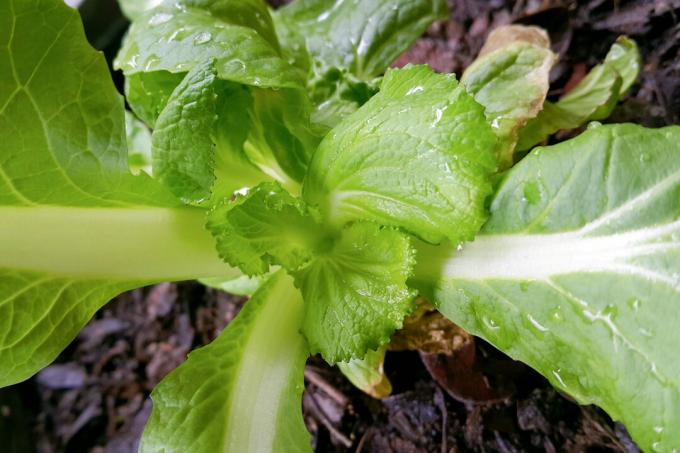Chinese cabbage: The all-round talent is enjoying increasing popularity. We provide tips and tricks for growing, harvesting and storing.

Chinese cabbage has been cultivated in China, Korea and Japan for many centuries. Since the 20th It has also been known in our latitudes for centuries. In its original homeland, Chinese cabbage is usually pickled with a type of fermented sauerkraut, which can also be very spicy. In South Korea you can find the so-called kimchi as a usual accompaniment to many dishes. Archaeological finds of clay pots show that such a preparation has been practiced for over 2000 years. Learn more about the Origin of Chinese Cabbage in our article.
contents
- Varieties of Chinese cabbage
- growing Chinese cabbage
- Harvesting and storing Chinese cabbage
- Diseases and harmful symptoms in Chinese cabbage
- Ingredients and uses of Chinese cabbage
Varieties of Chinese cabbage
There are now various types of Chinese cabbage on offer. In addition to the old varieties, modern F1 hybrids usually dominate in the garden centers of DIY stores. Some F1 hybrids are now against that too Clubroot resistant. With Scarlette there is now also a variety with reddish foliage.
an extensive one Varieties of Chinese cabbage you'll find here.
- garnet: cultivar with elongated heads and jagged leaf margins; Garnet is particularly valued for its good taste and delicate leaves; According to studies, the variety should have an above-average amount of vitamins.
- Hong Kong (F1): short, stocky and tightly packed heads; good taste.
- Kasumi (F1): very early variety with very good visual and flavor characteristics.
- Parkin (F1): Bolt-resistant and medium-early variety with resistance to clubroot. Medium sized heads with delicate and aromatic leaves.
- Scarlet (F1): the peculiarity of this variety are the red-purple leaves; the outer binders are still green with a slight purple tinge, the inner leaves are almost entirely red-purple in the heart; Scarlette is high-yielding and has a particularly mild aroma.
- Yuki (F1): medium-early variety with very firm heads; very mild taste.
growing Chinese cabbage
The tasty Chinese cabbage can also be grown in the home garden without any problems. It prefers a nutrient-rich soil in a sheltered and sunny to partially shaded spot. Contrary to what our readers frequently ask, the heat requirement is not as high as its main growing countries would suggest. A wind-protected location and a good supply of moisture are much more important.

Chinese cabbage counts as most cabbages to the heavy feeders. Poor soil should be repaired before planting the young plants. A primarily organic organic fertilizer such as our Plantura can be used for this Organic Tomato Fertilizer used with long-term effects. Alternatively, you can also use compost or some manure from organic animal husbandry.
The Chinese cabbage is usually planted quite late. It is therefore well suited as a follow-up crop for plants that were cleared early, such as carrots or beans. Sowing is not until mid-June to early August. You can grow the plants in smaller pots or sow them directly in the bed. The sowing depth is 1.5 cm. The distance between plants should be 30-40 cm and between rows 50-60 cm. At a soil temperature of 15 to 18° C, germination occurs within a week.
It is a typical root crop. If the soil is regularly loosened by hoeing, the cabbage will thank you with healthy growth and a high yield. When it is dry, it must always be watered.
Harvesting and storing Chinese cabbage
Depending on the variety, Chinese cabbage takes about 75-95 days to be harvested. Depending on the sowing, you can harvest in September, October and even November. Chinese cabbage tolerates light frosts without any problems and if not needed in the kitchen, it should remain in the bed for as long as possible. You can also protect the plants from frost with some fleece, large cardboard boxes or fir branches. Later and larger heads of cabbage can be stored better and longer. The head should be as firm as possible. However, do not wait too long, because temperatures that are too low damage the Chinese cabbage.
When harvesting, loose leaves should be removed and the plant should be cut off as low as possible at the root base. The petioles should not be injured, as this is a gateway for pathogens. The Chinese cabbage quickly begins to rot during storage.
Chinese cabbage can easily be stored in the refrigerator for about a week. If you smack the heads in damp newspaper or a damp towel, it can stay in the fridge for a few weeks. The Chinese cabbage can also be stored in a suitable, cool cellar. Although it is not advisable to freeze this type of cabbage, you can easily process the cabbage into a delicious Chi Kimchi and thus keep it for months. Kimchi is traditionally popular in Asia (especially Korea). It can best be described as fermented and spicy pickled sauerkraut.

Diseases and harmful symptoms in Chinese cabbage
The damage symptoms range from leaf damage (slugs or Cabbage White) via perforated leaves (flea beetles) up to Clubroot, a fungal disease that causes the roots of Chinese cabbage to thicken.
Ingredients and uses of Chinese cabbage
With a calorific value of only 10-18 kcal per 100g, Chinese cabbage is considered to be very low in calories. It can be added to mixed salads, served as a mild coleslaw or served as a stir-fry. If you are keen to experiment, you can try preparing the Korean kimchi.

